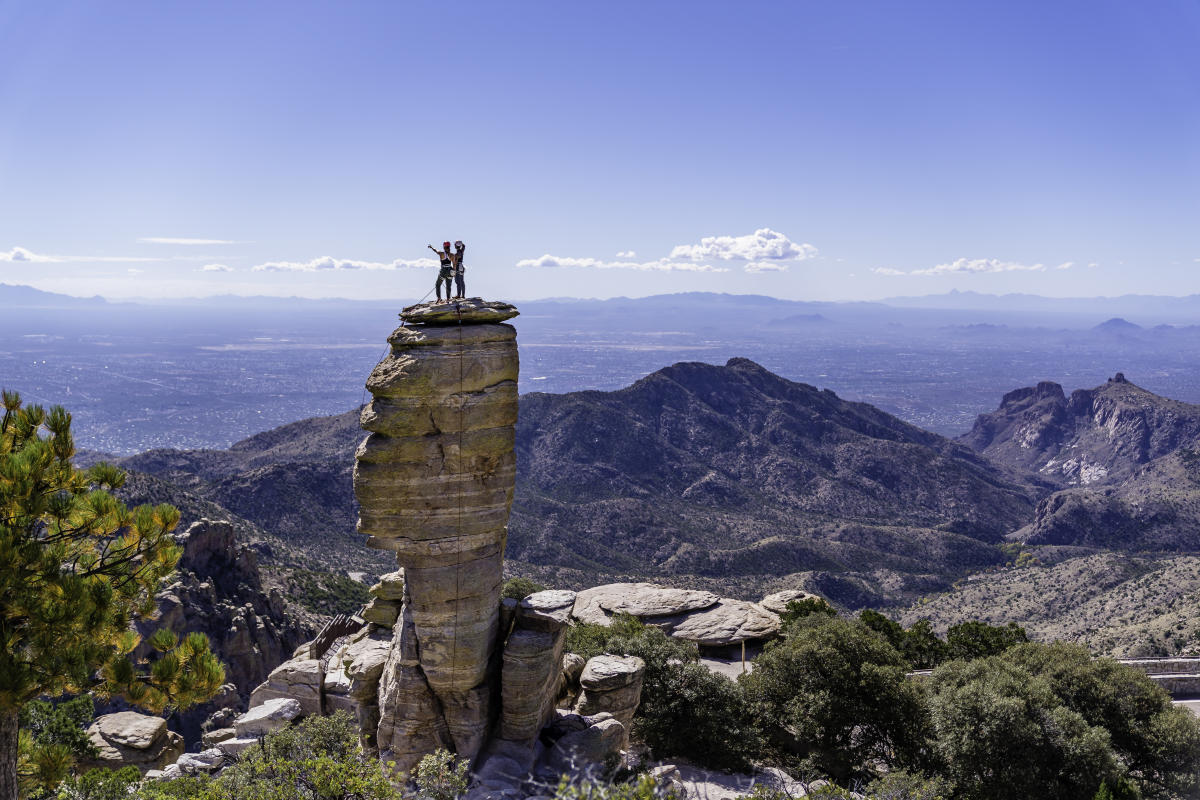Blessed with bright sunny weather and spectacular desert scenery, Tucson offers visitors plenty of fantastic attractions to fill their itineraries. From admiring cacti at iconic parks to exploring ancient history museums, discovering innovative arts scenes and enjoying tasty Southwest cuisine, Arizona’s “Old Pueblo” provides diverse diversions.
| Attraction | Description |
|---|---|
| Saguaro National Park | A park featuring the iconic saguaro cactus, offering trails for hiking, biking, and bird watching. |
| Arizona-Sonora Desert Museum | A combination of zoo, botanical garden, and museum showcasing the Sonoran Desert’s flora and fauna. |
| Old Tucson Studios | A historic film location and theme park with Wild West shows, rides, and attractions. |
| Mission San Xavier del Bac | A historic Spanish Catholic mission known for its beautiful architecture and active congregation. |
| Tucson Botanical Gardens | A garden offering diverse plant exhibits, butterfly exhibits, and sculpture gardens. |
| Biosphere 2 | A research facility offering tours of its biomes and exhibits on sustainability and environmental science. |
| Sabino Canyon Recreation Area | A natural area offering tram rides, hiking trails, and beautiful desert scenery. |
| Pima Air & Space Museum | An aviation museum with a large collection of aircraft and spacecraft, plus flight simulators. |
| Trail Dust Town | A recreated 1880s town with entertainment, rides, and historical exhibits. |
| Tohono Chul Botanical Gardens | A garden showcasing desert landscaping and cultural heritage with nature trails, art galleries, and cuisine. |
| University of Arizona Campus | The campus features museums, art installations, and educational attractions. |
| Titan Missile Museum | A museum offering tours of a Cold War-era Titan II missile site. |
| Reid Park Zoo | A zoo with a wide range of animals, educational programs, and conservation efforts. |
This list highlights 12 of Tucson’s top attractions drawing nature lovers, culture vultures, foodies and outdoor adventurers alike under its clear blue skies.
Saguaro National Park
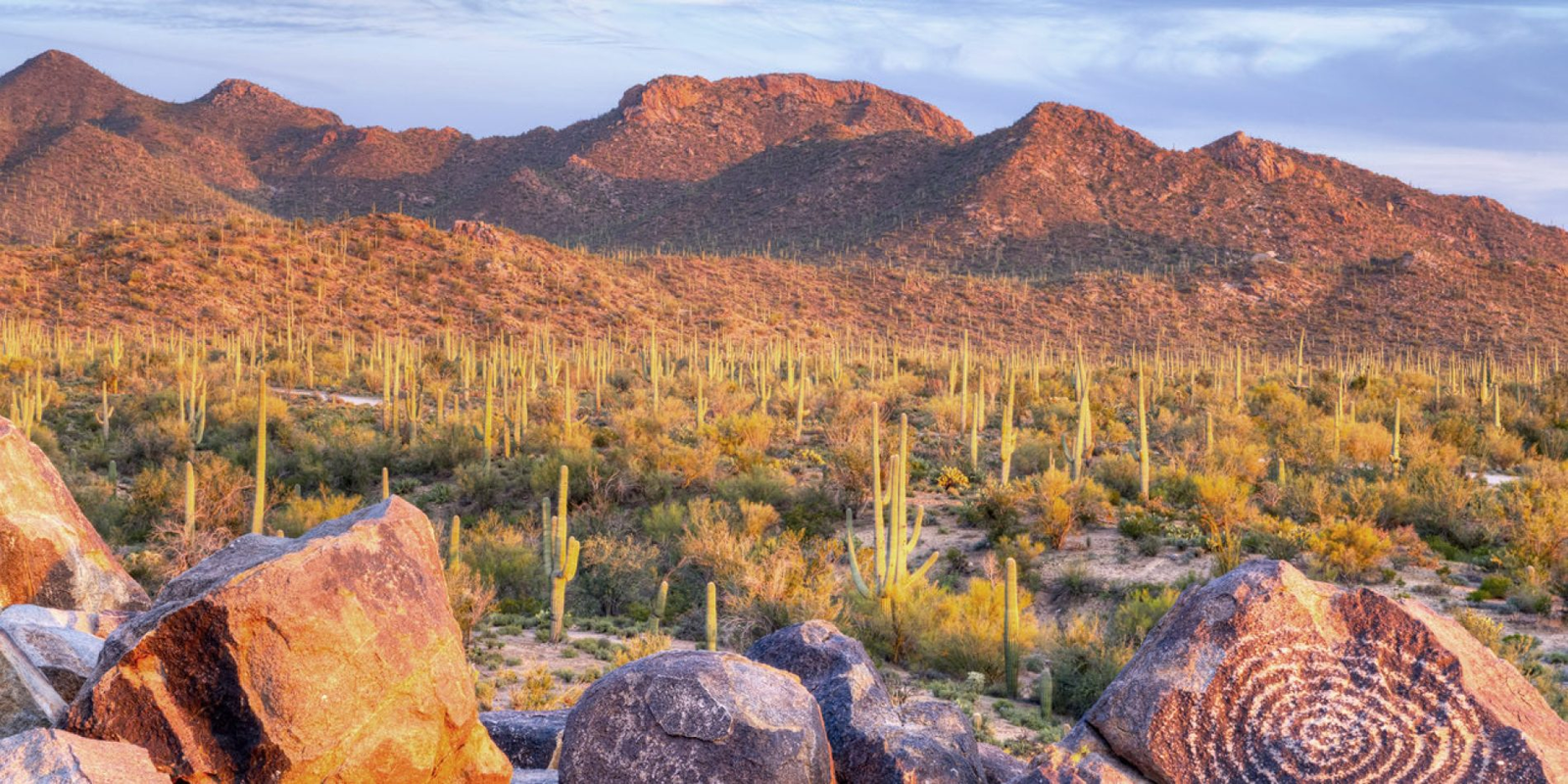
Name and Location: Saguaro National Park is located in southern Arizona, with districts on either side of Tucson. The park was created to protect the iconic saguaro cactus that thrives in the Sonoran Desert landscape.
History and Significance: Saguaro National Park was established in 1994, combining the previously designated Saguaro National Monument established in 1933 with additional land. The saguaro is a key part of the ecological community and sacred to native peoples. The park protects these majestic cacti and the unique desert habitat.
What to Expect: Visitors can hike, bike or ride horseback through saguaro forests and admire exceptional desert scenery and wildlife. Popular activities include ranger-led programs, camping, and photography of the scenic saguaros at sunset.
Visitor Information: The park is open year-round with an entrance fee of $25 per vehicle. Visit the Red Hills or Rincon Mountain districts, depending on which side of Tucson you’re on. Be prepared for remote desert hiking.
No Tucson visit feels complete without beholding the mighty saguaro cactus, and no place provides better access than Saguaro National Park protecting rare Sonoran Desert habitat. The park is divided into two sections bracketing the city. The smaller Rincon Mountain District east of town allows hiking among the namesake cacti accompanied by incredible sunsets.
The Tucson Mountain District west of the city similarly offers excellent saguaro sightings along 165 miles of trails welcoming hikers, equestrians and mountain bikers. Birders prize both districts for spying species preferring protected desert wilderness. From cute cactus wrens to majestic great horned owls, determined birders spot over 200 varieties. Thanks to the ubiquitous saguaro providing an iconic symbol of the region, Saguaro National Park ranks among Tucson’s most popular attractions.
Arizona-Sonora Desert Museum
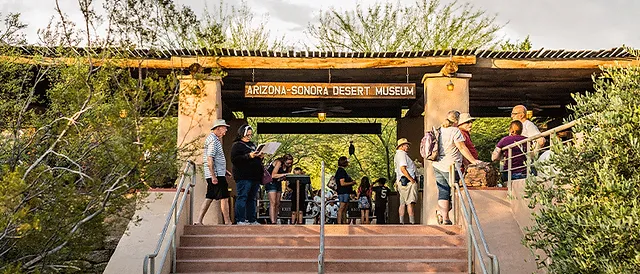
Name and Location: The Arizona-Sonora Desert Museum is a world-renowned zoo, natural history museum and botanical garden located just west of Tucson, Arizona.
History and Significance: Founded in 1952, it features plants and animals native to the Sonoran Desert. It is dedicated to interpreting the natural history of the region while promoting conservation. The museum is an acclaimed model for zoos around the world.
What to Expect: Visitors can explore recreated desert habitats with plants and wildlife on walking paths and exhibits. Highlights include the hummingbird aviary, Sonoran Desert habitat dioramas, and animal shows/talks.
Visitor Information: The museum is open year-round except Thanksgiving/Christmas. Admission fees apply. Plan to spend at least half a day. Visitor amenities include a café, gift shops, and an art gallery.
Expertly curated zoo, natural history museum and botanical garden experiences fuse together at the one-of-a-kind Arizona-Sonora Desert Museum occupying 98 acres west of downtown. Wildlife enclosures let visitors admire the Sonoran Desert’s diverse animal residents from playful coatis to graceful bighorn sheep up close.
Walking paths wind through regional plant exhibits like an exceptional cactus garden sheltering rare specimens. The museum’s art gallery, reptile house and mineralogy displays all interpret the desert’s natural wonders. Frequent demonstrations highlight animal training, raptor free flight and native crafts like Tohono O’odham basket weaving. With engaging sights guaranteed to entertain and educate, the Arizona-Sonora Desert Museum ranks among North America’s finest attractions of its kind.
Old Tucson Studios
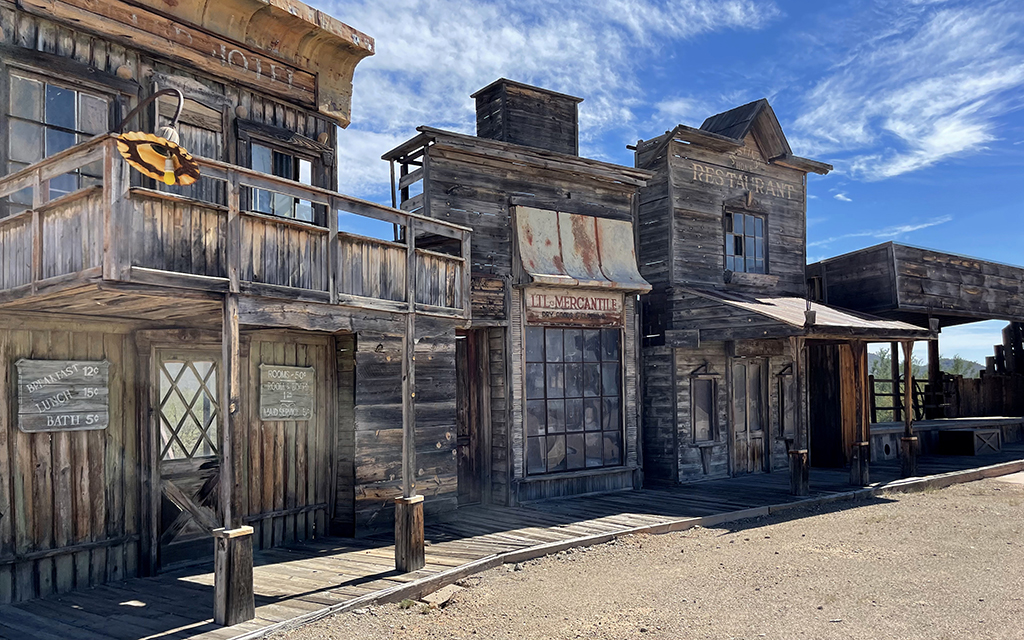
Name and Location: Old Tucson Studios is a Western-themed attraction located just west of Tucson, Arizona. It was originally built as a film set for Hollywood westerns.
History and Significance: Created in 1939 for the movie Arizona, it continued to be used for filming through the 1980s. Stars like John Wayne and Clint Eastwood acted there. It later opened for public tours and events.
What to Expect: Visitors can explore the historic movie studio buildings on guided or self-guided tours. Costumed actors perform shows and reenactments of scenes. Other attractions include stagecoach rides, cowboy stunt shows and living history demonstrations.
Visitor Information: Old Tucson is open year-round charging an entrance fee. Special evening events are also held. Amenities include gift shops, saloon, and on-site restaurant.
Classic Hollywood Western films like “Rio Bravo” and “El Dorado” starring John Wayne shot exterior scenes at Old Tucson Studios. Originally constructed in 1939, this family attraction recreates an authentic frontier town with entertainment staged daily. Visitors can enjoy gunfight stunt shows, ride an old steam train, pan for gold, watch a blacksmith demonstration or interact with cancan dancers and other Wild West performers.
Many of the wooden buildings remain unchanged from earlier cinematic heydays hosting stars from Glenn Ford to Steve McQueen. The arena also presents a professional rodea or two yearly filled with bronco riding, roping and bull riding. With echoes of Tombstone’s legendary history coupled with Hollywood nostalgia, Old Tucson Studios offers big dusty fun for all ages.
Mission San Xavier del Bac
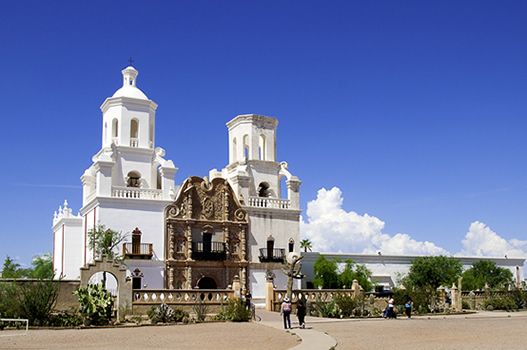
Name and Location: Mission San Xavier del Bac is a historic Spanish Catholic mission located about 10 miles south of downtown Tucson, Arizona on the Tohono O’odham San Xavier reservation.
History and Significance: The Mission was founded by Jesuit missionary Eusebio Kino in 1692, making it the oldest European structure in Arizona. Its elegant white adobe architecture with Moorish accents has earned it the nickname “White Dove of the Desert.”
What to Expect: Visitors can tour the historic church with its intricate interior decorations or attend Mass. The site’s museum documents its history. The Mission hosts annual events celebrating its heritage.
Visitor Information: The Mission is open daily to visitors year-round. Guided tours are available for a fee. Respectful attire is required and photos inside are not permitted.
Perhaps Tucson’s most iconic structure, the white-domed Mission San Xavier del Bac stands serenely 10 miles south of downtown just off I-19. Jesuit missionary Padre Eusebio Kino first erected a church here in 1700 to serve the Tohono O’odham tribe. The elegant Mexican Baroque style structure seen today dates from 1783 with Moorish and Spanish details added later. Marvelously restored in the 1990s, the mission interior dazzles with original statuary and murals.
The mission still actively serves San Xavier District tribal members with Sunday masses mixing ritual elements from traditional O’odham and Catholic faiths. A small museum documents the mission’s history and Kino’s legacy across what is now Southern Arizona and Northern Mexico. With incredible architecture against stunning desert backdrops, Mission San Xavier del Bac represents over two centuries of fascinating Tucson history.
Tucson Botanical Gardens
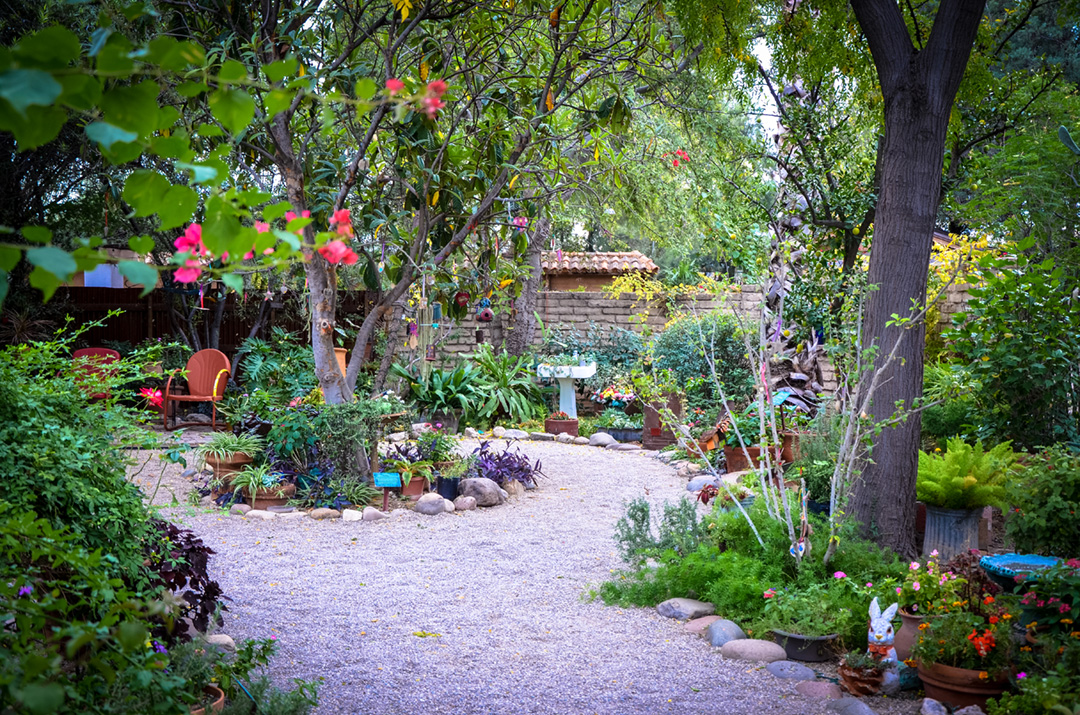
Name and Location: Tucson Botanical Gardens is a picturesque urban garden located downtown, showcasing regional plants from the Sonoran Desert and around the world.
History and Significance: Originally begun in the 1960s by citizens protecting endangered cacti, the garden has grown into an acclaimed public space supporting plant conservation.
What to Expect: Visitors walk through a variety of themed garden exhibits like the Cactus and Succulent Garden, Herb Garden, Butterfly Garden and more. Seasonal events, classes and exhibitions are also offered.
Visitor Information: The gardens are open year-round except major holidays, charging an entrance fee. Amenities include gift shop, café, and library. Wheelchair accessible.
Tucked away along the Rillito River bike path near the toe-sloping Santa Catalina Mountains, the family-friendly Tucson Botanical Gardens offers colorful serenity on its 5 acres. The Porter Sculpture Garden delights with over a dozen installations integrated with desert trees, floral displays and even whimsical fairy doors tucked amidst granite rocks. The dazzling Butterfly Magic exhibit shelters up to 2000 fluttering wings gliding past visitors in a temperature-controlled greenhouse from October through March.
Additional gardens demonstrate indigenous desert flora like barrel cacti and dry-climate palms from continents worldwide with identification labels. Onsite art galleries, gift shops, outdoor dining spaces and frequent music events mean something always captures visitors’ interests when walking the fragrant grounds. For an urban oasis celebrating regional ecology through art and science, Tucson Botanical Gardens rate as a top indoor/outdoor activity.
Biosphere 2
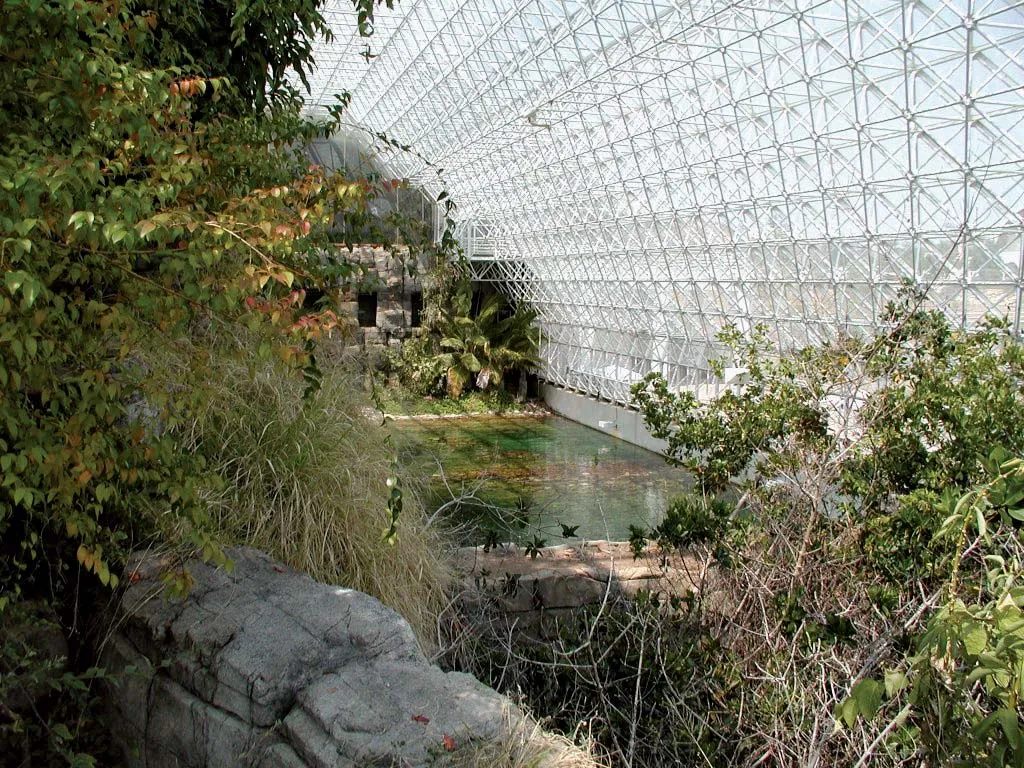
Name and Location: Biosphere 2 is a unique research site and public science center focused on the study of sustainable living systems, located about 30 miles north of Tucson, Arizona.
History and Significance: Originally built in the 1990s for closed ecological experiments, today Biosphere 2 runs climate change research projects using the sprawling glass-enclosed laboratory. Tours educate visitors about earth systems science.
What to Expect: Guests can take a guided walking tour through Biosphere 2’s exotic huge enclosed landscapes, once home to research teams. Exhibits cover experiments, wilderness conservation, and space colonization.
Visitor Information: Biosphere 2 requires timed-entry tickets for tours. Guests should plan on a minimum 2-hour visit. The site includes a gift shop/café. Budget extra driving time to reach this unique attraction.
Once an experimental enclosed human habitat managed by Columbia University, Biosphere 2 has transformed into a unique attraction operated by the University of Arizona. Visitors can take guided walking tours through the sprawling glass-covered facility’s tropical rainforest, coastal fog desert and savannah grassland biomes occupied from 1991-1993 by scientific crews in environmental isolation.
Expanded museum exhibits document the Biosphere 2 project’s legacy, spotlighting discoveries related to everything from water recycling to food production that continue influencing sustainability research. An onsite ethnobotanical garden cultivates heirloom crops from three distinct Native American farming cultures while monthly full moon adventure tours allow rare after-hours access. Providing one-of-a-kind glimpses into ambitious science supporting spaceship Earth, Biosphere 2 makes an ultra-memorable addition to any Tucson itinerary.
Sabino Canyon Recreation Area

Name and Location: Sabino Canyon Recreation Area is a popular natural preserve located minutes from Tucson, Arizona in the Santa Catalina Mountains, managed by the US Forest Service.
History and Significance: Settled by Native Americans, then miners, ranchers and homesteaders, today it invites respectful recreational use. Sabino Creek supports a rare perennial desert stream.
What to Expect: Visitors can walk, hike or take a tram tour to explore the canyon. Highlights include seven miles of creek, waterfalls, desert landscapes and plentiful wildlife along the trails.
Visitor Information: The recreation area is open year-round with a per-vehicle fee. Services include visitor center, tram tours, restaurant, gift shop and restrooms.
With craggy Santa Catalina peaks framing sandy Sonoran Desert canyonlands carved by Sabino Creek, Sabino Canyon Recreation Area situated 15 minutes northeast of Tucson immerses visitors within gorgeous high desert scenery. The park’s star activity means riding the narrated 45-minute Sabino Canyon Tram covering over 3 miles into the foothills through groves of saguaro cacti and trickling waterfalls over desert stone.
Disembarking partway and hiking downhill satisfies active explorers. The moderate Bear Canyon Trail crosses the creek to a swimming hole while other paths lead past petroglyph boulders or remnants of a historic dam. With convenient trailhead access to miles of trails suited for all skill levels, Sabino Canyon offers a little something for every outdoor enthusiast.
Pima Air & Space Museum

Name and Location: Pima Air & Space Museum displays civilian and military aircraft from around the world. It is located adjacent to Davis-Monthan Air Force Base in Tucson, Arizona.
History and Significance: Founded in 1976, it houses an acclaimed collection of over 300 aircraft, including many rare and one-of-a-kind flown in historic events. As the largest non-government funded air museum, it depends on visitor support.
What to Expect: Guests can explore hangars full of aircraft and related exhibits. Highlights include Presidential planes, WWII planes, experimental aircraft, and cockpits you can climb into. Guided tram and walking tours are available.
Visitor Information: The museum is open daily year-round, closing only Thanksgiving and Christmas. An entrance fee supports its mission. Visitor services include cafeteria, gift shops and shaded outdoor picnic area.
With 300 aircraft and spacecraft spread over 80 acres adjacent to Davis-Monthan Air Force Base, the Pima Air & Space Museum awes aviation enthusiasts with one of the world’s largest collections. Allow at least half a day to explore hangars and outdoor displays housing everything from a Wright brothers’ reproduction flyer to modern spy planes like the SR-71 Blackbird.
Expert docents share insider flying stories during tram tours, while flight simulators let visitors pilot aircraft virtually. Exhibits spotlight homegrown Tucson talents like astronaut Frank Borman and “father of the Mother Ship” conceptual artist Robert McCall. Spanning golden early barnstorming days through hopeful visions of commercial space travel, the museum’s impressive sights stay long rooted in memories.
Trail Dust Town
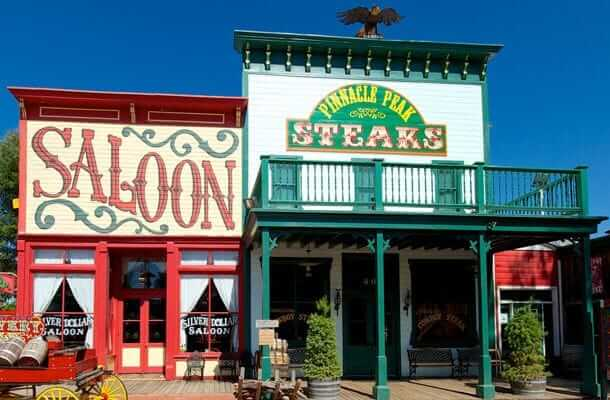
Name and Location: Trail Dust Town is an recreated 1880s style Wild West town and theme park located in Tucson, Arizona.
History and Significance: Built in 1960, Trail Dust Town entertains visitors with stunt shows, train robbery reenactments, cowboy cookouts, wagon rides, saloon entertainment, shops and more. Guests enjoy family-friendly Wild West fun.
What to Expect: Visitors can explore the wooden boardwalk streets past historic buildings filled with shops and eateries. Entertainment includes musical shows like the Trail Dust Melodrama, a stunt show, and the miniature Trail Dust Train.
Visitor Information: Trail Dust Town is open daily year-round charging an entrance free. Guests can pay for add-ons like train rides and cowboy cookouts. Free parking on-site.
Family fun awaits in this recreated 1880s frontier town filled with musical entertainment, carnival rides, stunt shows and historical attractions spread over 65 Old West-decorated acres in southeast Tucson. Visitors can ride the antique carousel, pan for gold, play mini golf or boot scoot across the dancehall floor. Every evening at dusk, actors perform lively Wild West stunt shows complete with bank robberies, cancan dancers and thundering horses circling the dusty streets with guns blazing.
Low-key museums document Southern Arizona mining and ranching history with antique equipment and an assay office. Shopping opportunities also abound with 20+ boutiques and eateries including the top-notch Pinnacle Peak Steakhouse. With vivid glimpses into kick-up-your-heels territorial days, Trail Dust Town offers first rate Western hospitality and amusement for all visitors.
Tohono Chul Botanical Gardens

Name and Location: Tohono Chul Botanical Gardens is a lush desert garden paradise located in northwest Tucson, Arizona. It focuses on native plants from the Sonoran Desert region.
History and Significance: Since founding in 1985, Tohono Chul has grown into a respected botanical garden, art gallery, and cultural center representing the heritage of the Sonoran Desert and the Tohono O’odham people native to the region.
What to Expect: Visitors can wander through cultivated gardens, wildflower meadow, demonstration gardens, and exhibits integrating native plants and art. The grounds also contain a teahouse, gift shop, and gallery.
Visitor Information: Tohono Chul is open year-round except major holidays, charging an entrance fee. An on-site bistro provides refreshments. Regularly scheduled cultural, art and nature-based events occur.
Spreading over 49 acres in north Tucson, Tohono Chul Botanical Gardens demonstrates diverse desert landscaping while celebrating Southern Arizona’s cultural heritage. Nature trails wind past cactus and wildflower displays plus serene fountains and water features evoking Spanish Colonial architecture seen regionally in mission churches. Galleries showcase Native American artworks like Hopi katsina dolls and jewelry alongside Hispanic retablos paintings rich in Catholic iconography.
Two onsite restaurants focus on righteous desert-sourced cuisine, while regular demonstrations highlight regional arts like native basketweaving using natural elements like yucca fibers. Through all exhibits, Tohono Chul emphasizes responsible usage of precious desert resources like rare Baja Arizona plants. For indoor and outdoor encounters with the Sonoran Desert’s unique natural and cultural legacies, Tohono Chul provides profound lessons.
University of Arizona Campus
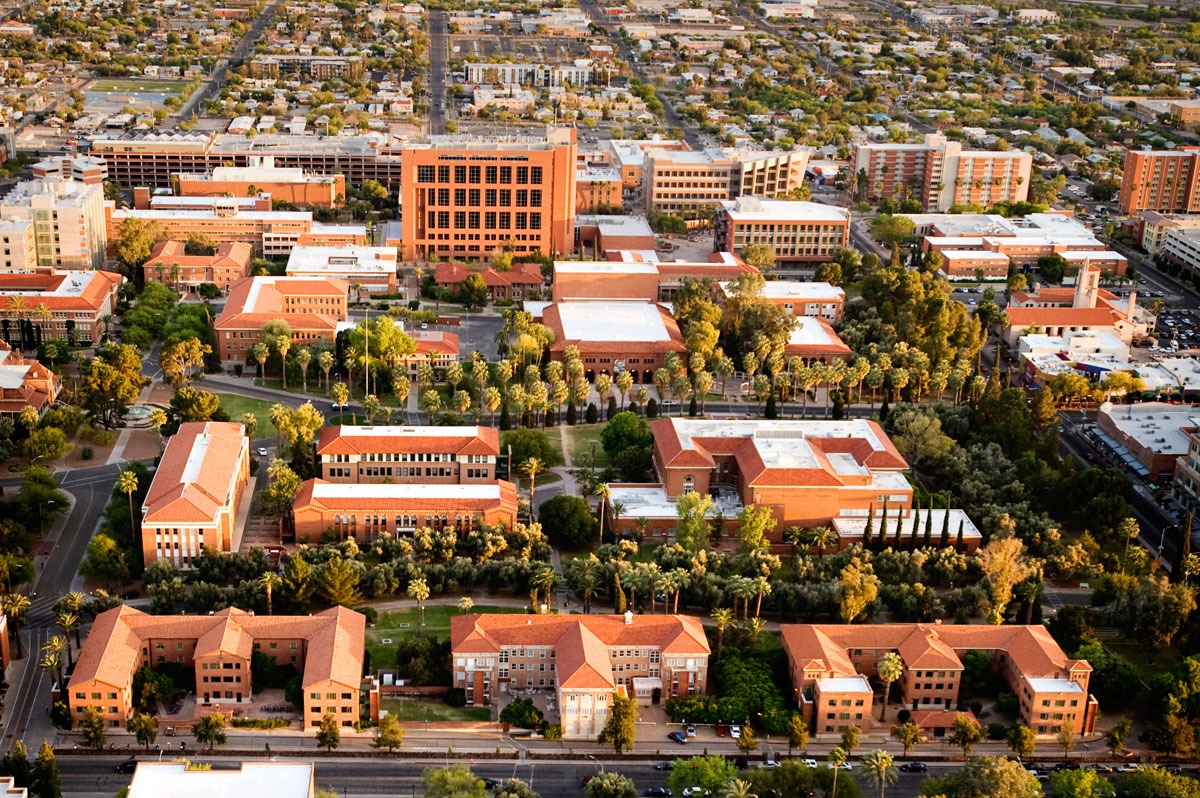
Name and Location: The University of Arizona is a major public research university located in central Tucson. It is the oldest university in the state, founded in 1885. The campus contains many historic buildings.
History and Significance: With over 44,000 students today, the UA campus houses acclaimed programs and faculties active in scientific research. Its Desert Lab furthers the study of arid lands. Historic architecture conveys its long legacy educating Arizona’s citizens.
What to Expect: Visitors can explore the campus by walking or using the free streetcar line. Highlights include the historic district, Arizona State Museum, Center for Creative Photography, Biosphere 2 exhibits, astronomy shows at UA SkyCenter, and performing arts events.
Visitor Information: Guests can access much of campus year-round for self-guided tours. Paid parking is available across campus. Visitor services are mainly concentrated along University Blvd. Guided tours may require reservations.
The University of Arizona’s main 380-acre campus in central Tucson offers beautiful grounds to walk plus top-notch museums free to all visitors. The Arizona State Museum spotlights artifacts from the region’s earliest human residents through contemporary Native peoples, hosting an exceptional Hopi collection. The gown-clad Kokopelli statue outside Percy L. Julian’s namesake chemistry building nods to the scientist’s trailblazing research.
The UA Poetry Center celebrates spoken and written arts through readings, print material archives and audio-visual media. More whimsical diversions include the Flandrau Science Center’s mineralogy oddities and planetarium shows. Public artworks like sculptor Joe O’Connell’s regal bronze Abstract Wildcat statue beckon throughout campus. For an easy taste of Tucson’s progressive spirit and appreciation for its cultural heritage stewards, visiting the University of Arizona’s diverse attractions opens minds.
Titan Missile Museum
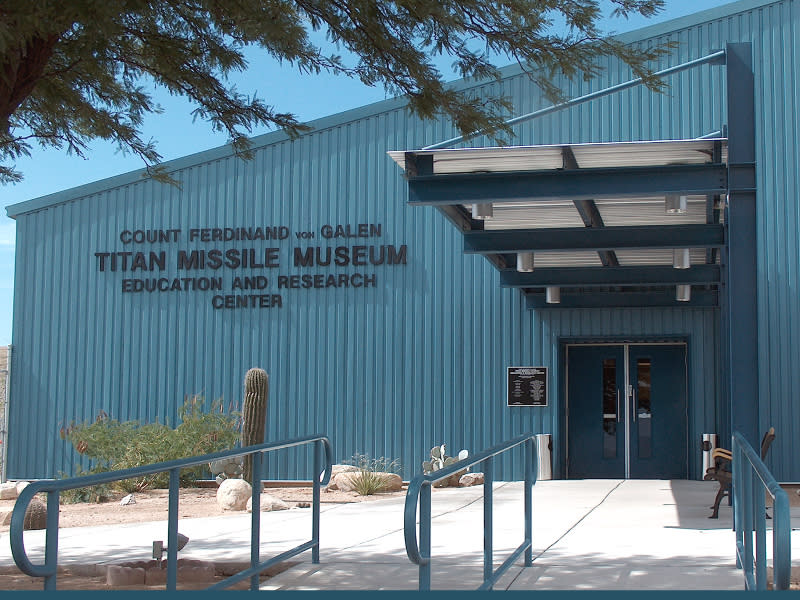
Name and Location: The Titan Missile Museum is a preserved Titan II nuclear missile site located 25 miles south of Tucson, Arizona. It is a National Historic Landmark.
History and Significance: An operational Titan II missile base during the Cold War, today it represents histories of space exploration and mutually assured destruction policies. It is the only Titan missile complex accessible to public visits.
What to Expect: Visitors tour the underground missile silo and control room to grasp the enormity of nuclear intercontinental ballistic missile systems, set within wider histories. Displays cover related science, space, and military history.
Visitor Information: The museum leads guided tours of this secure federal site. Reservations required for entry. Closed Thanksgiving and Christmas. Gift shop on-site. Budget driving time as the site is remote.
A truly unique Cold War site, the Titan Missile Museum provides an exclusive peak into America’s former underground nuclear warhead infrastructure. Hour-long tours take small groups down into the command center of Titan II ICBM silo complex officially deactivated in 1982. View 1960s switch panels, code-to-arm systems and the immense retired missile still resting horizontally in its launch duct.
Expert guides explain key training, protocols and communication networks supporting Titan II operations during MAD-driven decades of remote desert missile crew deployments. Surface exhibits additionally cover uncrewed space rocket variants launched nearby to deliver NASA satellites and spacecraft for decades. As the only publicly accessible Titan base, this National Historic Landmark spotlights sobering military technology helping protect Pax Americana and advance the Space Race.
Reid Park Zoo

Name and Location: Reid Park Zoo is a mid-sized zoo located within city-owned Reid Park in Tucson, Arizona. It displays exotic animals from around the world.
History and Significance: Founded in 1967, the zoo has focused on animal conservation efforts, education and enhanced exhibits over time. Special highlights include the giant anteaters and Komodo dragon on display.
What to Expect: Visitors can explore zoo grounds viewing tropical animals like rhinos/giraffes, Australian animals like wombats/kangaroos, a South American rainforest habitat, and more flightless birds, big cats, primates and reptiles.
Visitor Information: Reid Park Zoo is open daily except major holidays, charging an admission fee. Amenities include gift shop, on-site food options, and shaded sitting areas. Stroller/wheelchair rental available.
Spread across compact but packed acres in central Reid Park near busy Broadway Boulevard, Reid Park Zoo impresses visitors with expertly designed exhibits lively with diverse creatures like towering giraffes, roaring lions, playful otters and more fan favorites. Shaded paths wind past creekside lemur islands, flamingo lagoons and spacious elephant and rhino paddocks with educational games and lore posted frequently.
Active expansion plans emphasize visionary immersion experiences transporting guests to tropical Asian and South American habitats through free-flight aviaries and bio-dome spaces. Until fresh exhibits open in coming years, the zoo’s tucked-away tranquil setting right in the city center helps educate and inspire budding conservationists.
Conclusion
From sublime sunsets over saguaro sentinels to exhilarating rollercoasters screeching around dusty movie sets, Tucson attractions encapsulate the city’s welcoming spirit rooted in awesome natural surroundings. Visitors soak up culture at Spanish-infused architectural gems like San Xavier Mission and forward-thinking science meccas like Biosphere 2 equally. Family-friendly animal encounters at Reid Park Zoo and the Arizona-Sonora Desert Museum share the spotlight with great local eats always done just right Tucson style. Rustic dude ranch tours turn back the clock to Arizona Territory days, while University of Arizona’s modernized campus progresses global research benefiting all humanity. Sample experiences as diverse as Tucson itself from this list highlighting the Old Pueblo’s happy capacity for blending cutting edge programs with warm hospitality and respect for its unique borderlands history.

